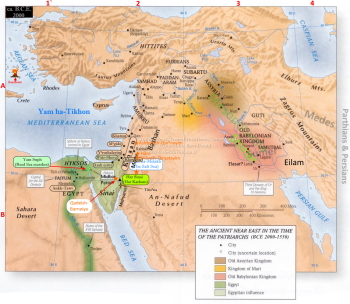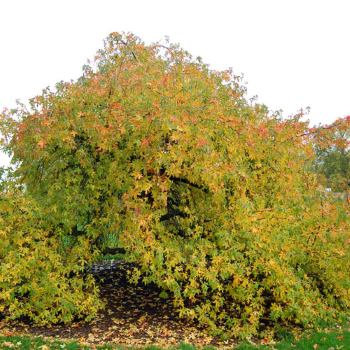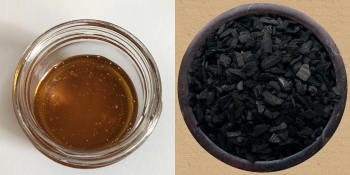
 |

 350x197.jpg) |
 350x197.jpg) |
As Yo•seiphꞋ's 11 brothers saw him approaching Dō•tânꞋ, they said to one another, "Look, dream-boy's coming! Let's go kill him and throw his body into one of the pits! We'll say that some predatory animal killed him and ate him. Then we'll see what becomes of his delusions of grandeur."
When Rᵊu•veinꞋ heard that, he rescued Yo•seiphꞋ from their hands, suggesting, instead, "Let's not strike his nëphꞋësh. Don't spill any blood," he continued. "Send him into this pit in the mi•dᵊbârꞋ, but don't put a hand upon him." (So that Rᵊu•veinꞋ might return later to rescue Yo•seiphꞋ and return him to his father, Yi•sᵊr•â•eilꞋ.)
When Yo•seiphꞋ arrived, his brothers stripped off his striped caftan and they took him and sent him into a nearby dry-well pit. Then they sat down to a bread-dinner.![]()
 |
As they were eating, they noticed in the distance an ancient convoy of truckers – a caravan of their Arab cousins, sons of their great-uncle Yi•shᵊm•â•eilꞋ, returning from a business trip to Gi•lᵊâdꞋ, with their camels transporting incense resins: Tragacanth gum,![]() “Balm of Gi•lᵊâdꞋ” sweetgum
“Balm of Gi•lᵊâdꞋ” sweetgum![]() and “Rose of Sharon” Ladanum,
and “Rose of Sharon” Ladanum,![]() headed south to sell them in Mi•tzᵊraꞋyim.
headed south to sell them in Mi•tzᵊraꞋyim.
"I have an idea," YᵊhudꞋâh exclaimed. "Where's any money in killing our little brother and covering-up his blood? Let's go sell him to the Yi•shᵊm•â•eil•imꞋ (who lived in Mi•dᵊyânꞋ). Then we won't have laid a hand on him, for he is our brother and our flesh." And his brothers hearkened to him.
As the Mi•dᵊyân•imꞋ merchant men were passing by, they pulled Yo•seiphꞋ up out of the pit and his brothers sold him to their Yi•shᵊm•â•eil•imꞋ-Mi•dᵊyân•imꞋ cousins for 20 silver shᵊqal•imꞋ.![]() And the Yi•shᵊm•â•eil•imꞋ transported Yo•seiphꞋ to Mi•tzᵊraꞋyim.
And the Yi•shᵊm•â•eil•imꞋ transported Yo•seiphꞋ to Mi•tzᵊraꞋyim.
When Rᵊu•veinꞋ returned to the pit, Yo•seiphꞋ was gone. So Rᵊu•veinꞋ ripped his caftan in grief![]() and returned to his brothers, saying, "The boy isn't there! What have I come to?"
and returned to his brothers, saying, "The boy isn't there! What have I come to?"
Then they took Yo•seiphꞋ's caftan, slaughtered a billy-goat, dipped the striped caftan in the blood and they brought it to their father, saying, "We found this. Isn't this your son's caftan?"![]()
Recognizing it immediately, he sobbed, "It's my son's caftan. Some bad creature has devoured him. Tâ•rōphꞋ tō•raphꞋ is Yo•seiphꞋ!" And Ya•a•qovꞋ ripped his caftan in grief![]() and dressed his hips in a sack and mourned many days for his son.
and dressed his hips in a sack and mourned many days for his son.
So all of Yi•sᵊr•â•eilꞋ's sons and daughters rose to comfort him, but he refused to be comforted, saying, "I will go down to my son, mourning toward Shᵊōl." And his father wept for him.
Meanwhile, in Mi•tzᵊraꞋyim, the Mi•dᵊyân•imꞋ sold him to Pō•ti-pharꞋ, a eunuch of the Par•ohꞋ and Minister of the Palace Chefs.

Optional parental preparation:
Westerners may grab a slice of bread, or make a quick sandwich, eat on the run and think nothing of it. However, in ancient Judaic tradition, inclusion of bread typically implies a full-spread, especially some celebratory, bâ•sârꞋ (in ancient times, only the wealthy ate meat except for very special occasions), dinner preceded by washing hands with a bᵊrâkh•âhꞋ, followed by a special bᵊrâkh•âhꞋ over salted bread.![]()
![]()
÷ÀøÄéòÈä – The act of tearing the fabric of one's caftan is first mentioned when Rᵊu•veinꞋ returns to rescue Yo•seiphꞋ only to discover that he was gone from the pit; and next when Yi•sᵊr•â•eilꞋ is confronted with the bloody caftan that had belonged to Yo•seiphꞋ (bᵊ-Reish•itꞋ 37.29, 34). The act is presented as an established ancient Middle East custom, venting the inexpressible, uncontainable grief of a loved one being ripped from one's heart. Modern erosions have lost the essence. Scissors, knife and razor blade (even more so, substituting a black ribbon) demonstrates that concern for the cost—money—of destroying one's garment exceeds, and takes priority in one's nëphꞋësh over, the uncontainable need to vent an inexpressible grief for the loss of the loved one; infusing a money valuation into one's own nëphꞋësh. ![]()
ðÀëÉàú – Tragacanth is used both for diarrhea and constipation. It is also an ingredient in toothpastes, hand lotions, denture adhesives, and vaginal creams and jellies.In foods, tragacanth is important for stabilizing and thickening ingredients in salad dressings, foods, and beverages. In pharmaceutical products, tragacanth is used as a binding agent. Tragacanth contains ingredients that stimulate the movement of the intestines. (webmd.com; 2016.10.06) ![]()
 350x263.jpg) |
 350x259.jpg) |
öÀøÄé, aka ðÈèÈó — Levant Storax 'Balm of Gi•lᵊâdꞋ’ sweetgum tree (Liquidambar orientalis),![]() for incense perfume.
for incense perfume. ![]()
 |
 |
| öÀøÄé, aka ðÈèÈó — Levant Storax 'Balm of Gi•lᵊâdꞋ’ (Liquidambar orientalis), |
 Lot-Shekhelet rock Rose Sharon Onycha resin 0350x175.jpg) |
| ìÉè, aka ùÑÀçÅìÆú, Rose of Sharon (aka rock rose; Cistus creticus, aka C. incanus |
 Lot-Shekhelet rock Rose Sharon Onycha shrubs 350x263.jpg) |
 Lot-Shekhelet rock Rose Sharon Onycha raking mauve-only resin 0400x300.jpg) |
| ìÉè, aka ùÑÀçÅìÆú, Rose of Sharon (aka rock rose; Cistus creticus, aka C. incanus) — Leather thong rakes (in photo |
Ladanum is the onyx-like, gray-black resin that exudes from the branches of the Rose of Sharon / Rock Rose bush. When it matures, ladanum becomes black and is referred to as black amber or black balsam.![]()
Sticky onyx-color (Onycha) ladanum-resin collects on the beards of goats (and wool of sheep) as they graze. Ladanum is then harvested by combing the beards and thighs![]() of goats and wool of sheep that had grazed on the cistus shrubs.
of goats and wool of sheep that had grazed on the cistus shrubs.![]() Thus, ladanum became associated with goat’s beard. The resin was used as an ingredient for incense.
Thus, ladanum became associated with goat’s beard. The resin was used as an ingredient for incense.
The Pharaoh’s beard was made up of goats’ hair,![]() which was held together and scented by ladanum.
which was held together and scented by ladanum.![]() When the royal kingly Pharaoh spoke it was as the lion's “roar,” the voice of
When the royal kingly Pharaoh spoke it was as the lion's “roar,” the voice of god to the people. The Pharaoh was called the "incarnation of [Aten].![]() Massy writes that, "The lion was a zootype of [
Massy writes that, "The lion was a zootype of [Aten]… He is called the lion-faced in the Ritual… He is addressed as a lion god, the god in lion form."![]() Pharaohs were often depicted as part human and part lion wearing the false beard saturated with ladanum. A sphinx of Pharaoh Khat-shepset displays a lion's mane and the pharaoh's manufactured beard.
Pharaohs were often depicted as part human and part lion wearing the false beard saturated with ladanum. A sphinx of Pharaoh Khat-shepset displays a lion's mane and the pharaoh's manufactured beard.![]()
![]()
![]()
Questions you might anticipate that your child might raise and be prepared to discuss:
What is a delusion of grandeur?
What does predatory mean?
What is resin?
What's a hip?
Consider how you might want to answer if asked what is a eunuch? (ñÀøÄéñ)
![]()
 |
 |